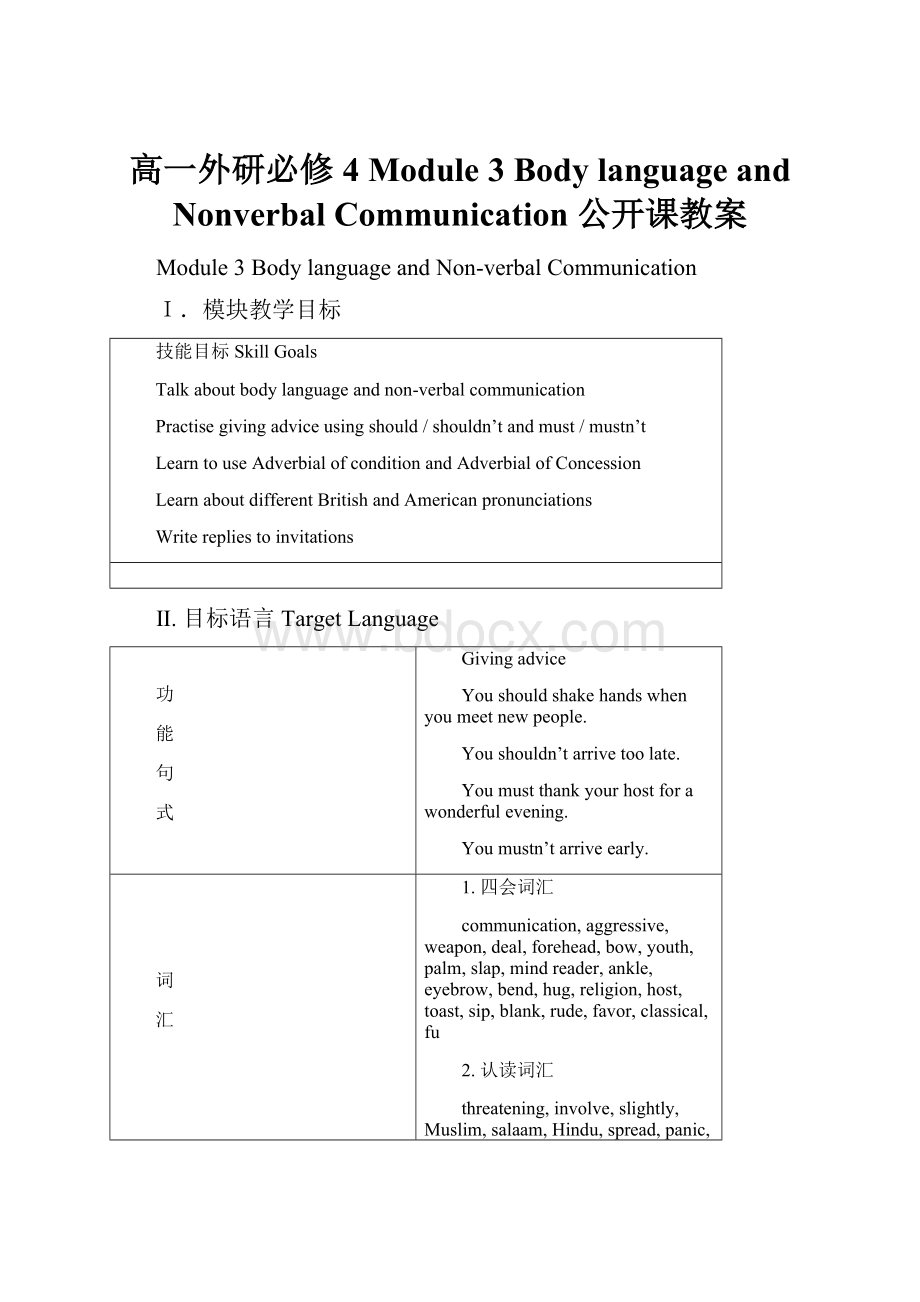 高一外研必修4 Module 3 Body language and Nonverbal Communication公开课教案.docx
高一外研必修4 Module 3 Body language and Nonverbal Communication公开课教案.docx
- 文档编号:11237656
- 上传时间:2023-02-26
- 格式:DOCX
- 页数:51
- 大小:251.27KB
高一外研必修4 Module 3 Body language and Nonverbal Communication公开课教案.docx
《高一外研必修4 Module 3 Body language and Nonverbal Communication公开课教案.docx》由会员分享,可在线阅读,更多相关《高一外研必修4 Module 3 Body language and Nonverbal Communication公开课教案.docx(51页珍藏版)》请在冰豆网上搜索。

高一外研必修4Module3BodylanguageandNonverbalCommunication公开课教案
Module3BodylanguageandNon-verbalCommunication
I.模块教学目标
技能目标SkillGoals
Talkaboutbodylanguageandnon-verbalcommunication
Practisegivingadviceusingshould/shouldn’tandmust/mustn’t
LearntouseAdverbialofconditionandAdverbialofConcession
LearnaboutdifferentBritishandAmericanpronunciations
Writerepliestoinvitations
Ⅱ.目标语言TargetLanguage
功
能
句
式
Givingadvice
Youshouldshakehandswhenyoumeetnewpeople.
Youshouldn’tarrivetoolate.
Youmustthankyourhostforawonderfulevening.
Youmustn’tarriveearly.
词
汇
1.四会词汇
communication,aggressive,weapon,deal,forehead,bow,youth,palm,slap,mindreader,ankle,eyebrow,bend,hug,religion,host,toast,sip,blank,rude,favor,classical,fu
2.认读词汇
threatening,involve,slightly,Muslim,salaam,Hindu,spread,panic,live,judgment,prolong,equality,handclap,infectious,funeral,RSVP
3.词组
byaccident,giveaway,holdup,liftup,makeadeal,onguard,sayhelloto,switchon,upanddown
4.重点词汇
communicate,unconscious,vary,formal,traditionally,gesture,stare,wipe,wrist,invitation,performance,applause,request
语法
Adverbialclauseofcondition条件状语从句
Adverbialclauseofconcession让步状语从句
重
点
句
子
1.Ifyousaytheword“communication”,mostpeoplethinkofwordsandsentences.
2.Althoughtheseareveryimportant,wecommunicatewithmorethanjustspokenandwrittenwords
3.Weusedthe“learned”bodylanguagewhenweintroducedtostrangers
4.Likeotheranimals,weareonguarduntilweknowitissafetorelax.
5.Nowadays,itisquiteacommongreeting.
6.Playswereoftenincompetitionwitheachother...
III.教材分析与教材重组
1.教材分析
本模块的中心话题是“肢体语”和“非言语交际”,所谈论的话题涉及打招呼,拍手,文化意识等,旨在通过模块教学使学生学会使用描述“肢体语”和“非言语交际”的词汇,就“肢体语”和“非言语交际”这一话题发表建议、观点,并能写出合乎规范的请柬和回复。
1.1INTRODUCTION通过设置的四幅图片和听力训练,谈论各种情况下的肢体语,这一部分呈现了本模块的中心话题,学生可以复习巩固有关体态的词汇。
1.2READINGANDVOCABULARY是有关世界各地打招呼的体态语,在这一部分中,学生除学习新的词汇、句型和训练阅读技巧外,对打招呼的体态语也有更深刻的认识。
1.3GRAMMAR1呈现了条件状语从句并辅以练习,使学生对条件状语从句有初步认识。
1.4LISTENINGANDVOCABULARY分两部分,一部分是学习有关身体部位的词汇,另一部分是听力训练。
这两部分不仅使学生学习新词、也训练其听力。
1.5FUNCTION呈现了用SHOULD和SHOULDN’T、MUST和MUSTN’T提建议并辅以练习,使学生掌握用SHOULD和SHOULDN’T、MUST和MUSTN’T提建议这一用法。
1.6GRAMMAR2再次呈现了条件状语从句,同时辅以练习,使学生在GRAMMAR1的基础上,进一步了解条件状语从句的用法。
至此,学生对条件状语从句有一个整体的认识。
1.7PRONOUCIATION通过听英语、美语两种不同的方言,让学生辨别英、美语在发音上的一些差异。
1.8SPEAKING是让学生谈论有关中国的风俗习惯,并练习条件状语从句以及SHOULD和SHOULDN’T、MUST和MUSTN’T的用法。
同时培养学生的合作精神。
1.9GRAMMAR3呈现WH-WORD+EVER引导的让步状语从句的基本用法。
设置的练习使学生对WH-WORD+EVER引导的让步状语从句有一定的认识。
1.10WRITING这一部分是设置了两篇请柬,让学生学会写正式与非正式请柬以及回复,使学生了解并掌握这一应用文体。
1.11EVERYDAYENGLISH是让学生掌握一些日常用语的真实意思,避免望文生义。
1.12CULTURALCORNER是一篇介绍“拍手”这一手势语的文章,通过阅读使学生不仅训练泛读技巧,也使学生了解拍手的起源和拍手的不同场合。
1.13TASK要求学生就一些社交话题写出建议。
这一部分不仅培养学生的写作能力而且使学生复习巩固条件状语从句及SHOULD和SHOULDN’T、MUST和MUSTN’T的用法。
2.教材重组
2.1从训练目的上看INTRODUCTION与PRONOUNCIATION以及WORKBOOK中的LISTENINGANDSPEAKING相一致;从教材分量上分析可将这三部分整合在一起,设计一节“听说课”。
2.2把READINGANDVOCABULARY上一节“阅读课”。
2.3将GRAMMAR1、2、3和WORKBOOK中的GRAMMAR整合在一起,上一节“语法课”。
2.4将LISTENINGANDVOCABULARY,FUNCTION,SPEAKING,TASK,EVERYDAYENGLISH以及WORKBOOK中的VOCABULARY整合在一起,上一节“综合技能课”。
2.5将CULTURALCORNER和WORKBOOK中的READING整合在一起,上一节“泛读课”。
2.6将WRITING和WORKBOOK中的WRITING整合在一起上一节“写作课”。
3.课型设计和课时分配(根据对教材和学情的分析,本单元可分六课时教授)
1stperiodListeningandSpeaking
2ndperiodReading
3rdperiodGrammar
4thperiodIntegratingSkills
5thperiodExtensiveReading
6thperiodWriting
Ⅳ.分课时教案
TheFirstPeriodListeningandSpeaking
Teachinggoals教学目标
1.Targetlanguage目标语言
a.重点词汇和短语
point,shake,smile,wave
b.重点句子
Saywhatyoudowhenyouareintroducedtosomeone.
Ishakehandsandsay“pleasedtomeetyou”.
Youshouldn’topenthegiftimmediately.
2.Abilitygoals能力目标
Enablethestudentstolearntotalkaboutbodylanguageandnon-verbalcommunication.
EnablethestudentstolearnthedifferentpronunciationsbetweenBritishandAmericanEnglish.
Enablethestudentstolearnaboutthegift-givingcustomsaroundtheworld.
3.Learningabilitygoals学能目标
Enablethestudentstolearnhowtotalkaboutbodylanguageandnon-verbalcommunication.
Teachingimportantanddifficultpoints教学重点和难点
Getthestudentstolearnhowtotalkaboutbodylanguageandnon-verbalcommunication,andlearnaboutthegift-givingcustomsaroundtheworld.
Teachingmethods教学方法
Talking,listeninganddiscussing.
Teachingaids教具准备
Acomputer,aprojectorandarecorder.
Teachingprocedures&ways教学过程与方式
StepⅠLead-in
T:
Usually,whenwesaysomething,weliketomoveourhands,headoreyes.Whatisit?
S:
It’sbodylanguage.
T:
Forwhatdoweusebodylanguagewhenwespeak?
S:
Toexpressourselvesmoreclearlyorvividly.
T:
Sometimes,wedon’tsawanything,butwecanunderstandeachother.Why?
S:
Weuseourbodylanguage.
T:
Somebodyisunabletospeak.Wecallthemdummy.Howcantwodummiestalkwitheachother?
S:
Theytalkwitheachotherwiththeirbodylanguage.
T:
Whatisbodylanguage?
S:
Bodylanguageisthemovementsorpositionsofourbodythatshowotherpeoplewhatwearethinkingorfeeling.
StepⅡWarmingup
Getthestudentstotalkaboutthepicturesonthescreen.
T:
Lookatthepicturesonthescreenanddiscussthemeaningofthem.Tellmeyouranswers.
Ss:
1OK!
2Stop!
3Bequiet!
4Great!
/Wonderful!
T:
Youareright!
Theyareallgestures.Doyouonlyuseyourhandstomakegestures?
Ss:
No.
T:
Whatelsecanweusetomakegestures?
Ss:
Faces,eyes,mouths,arms,feet,legs,bodiesandsoon.
T:
Sowecallthesegesturesbodylanguageornonverbalcommunication.Howmuchdoyoucommunicatewithyourbody?
1Notatall2Notmuch3Alot4Morethanyouthink5Morethanwithwords?
Why?
Sa:
Notmuch.I’mnotanactivegirl.
Sb:
Alot.IthinkIcanexpressmyselfmoreclearlywithbodylanguage.
Sc:
MorethanIthink,becauseIsometimesusebodylanguageunconsciously.
Sd:
Morethanwithwords,IthinkIusebodylanguageatalltimes.
T:
Verygood!
StepⅢIntroduction
GetthestudentstodothespeakingandlisteninginINTRODUTION.
T:
Nowopenyourbooks,turntoPage21,lookatthepicturesandguesswhatthepeoplearedoing.
Sa:
Thetwoyouthsarepossiblyaskingandtellingsomething.
Sb:
Theladyislikelytosay“Goodbye!
”tosomebody.
Sc:
Maybethewhitemaniswelcomingtheblackman.
Sd:
Perhapsthetwomiddle-agedpeoplearegreeting.
T:
Maybeyouareright.Let’smatchtheverbsintheboxwiththepictures.Nowlistentothetapeandmatchthesituationswiththepictures.OK,let’sdoActivity3.Discusswhatyoudowhenyouareintheeightsituationsinpairs.Whovolunteertotellusyouranswers?
S1:
Ismileandsay,“Howareyoudoing?
”
S2:
Ipointtothewayandsay,“Gothiswayplease.”
S3:
Iwavemyhandandsay,“Hello!
”
S4:
Igivehimthegiftandsay,“Happybirthdaytoyou!
”
S5:
Inodmyhead.
S6:
Ishakemyhandsandmyhead.
S7:
Iopenmyeyeswidepointingatmyselfwithmyindexfinger.
S8:
Ishakehandsorhughim.
T:
Howcanyouusebodylanguagetocommunicatethefollowingideas?
Teachershowsthemonthescreen.Letstudentsdiscussingroups.
1.Youareenjoyingsomething.
2.Youlikesomeone.
3.Youareinterestedinwhatsomeoneissaying.
4.Youdisagreewithwhatsomeoneissaying.
5.Youarenotenjoyingsomething.
6.Youwanttoleavebecauseyouareinahurry.
7.Youarenotinterested.
8.Youwouldliketotalktosomeone.
Answerswillvarybuthereareafewappropriatewaystocommunicateeachfeelingusingbodylanguage.
S1:
smiling,openingeyeswide,rockingone’sheadfromsidetoside
S2:
smiling,huggingoneself,leaningone’sheadtooneside,loweringwithone’seyes,leaningforwardorcloser
S3:
staringalot,puttingahandtoyourchinasinthought,leaningforward,openingeyeswide,shapingyourmouthwiththesameexpressionsasthepersonwhoyou’relisteningto
S4:
lookingaway,puttingone’sheaddownintoone’sarms,talkingtooneself,whistling,frowning,foldingone’sarms
S5:
yawning,sighing,complaining,frowning,lookingaway
S6:
sighing,bitingdownwithone’steeth,notstandingstill,tappingone’stoesonthefloor,lookingtowardthedoor
S7:
sameasnotenjoying
S8:
raisingone’shandtobecalledon,tryingtospeakup,wavingone’sarmsoverone’sheadtogetattention,jumpingupanddown,andshapingone’smouthinabigO
T:
Lookatthewordsintheboxesandmakesurethatyouknowwhattheymean.Worktogetherwithyourpartnerandtrytothinkofhowthesepartsofyourbodycanbeusedto“talk”tosomeone.Foreachbodypart,trytocomeupwithatleasttwodifferentgestures.Thefirstonehasbeendoneasanexample.
1fist2hip3thumb4indexfinger5cheek6palm
S1:
Shakingyourfistatsomeoneisawaysayingthatyouareverystrong.
Bendingyourarmandmakingafististosaythatyouarestrong.
S2:
Swingingyourhipsisawayofsayingyou’rehappyorinagoodmood.
Pushingyourhipstotheleftortherightcanbeawaytopushpeopleoutofyourway.
S3:
Puttingyourthumbuptoexpressthatyoulikesomething.
Bitingyourthumbistoshowstrongdislike.
Stickingyourthumboutfromanextendedarmistoaskforaride.
S4:
Pointingyourfingertoscoldsomeone.
Turningyourpalmupandbendingyourfingertowardyoutoasksomeonetocometoyouorfollowyou.
Tappingyourfingertoyourheadistotellsomeonetothinkcarefully.
Puttingyourfingertoyourlipsistoasksomeonetobequietorwhisper.
S5:
Kissingyouonthecheekistoshowaffectionortogreetsomeone.
Slappingsomeone’scheekistoexpressyourangeratbeinginsulted.
Scratchingyourcheekwithyourfingersistoshowthatyou’reconfused.
S6:
Puttingyourhandsoutinfrontofyouwithyourpalmsup
- 配套讲稿:
如PPT文件的首页显示word图标,表示该PPT已包含配套word讲稿。双击word图标可打开word文档。
- 特殊限制:
部分文档作品中含有的国旗、国徽等图片,仅作为作品整体效果示例展示,禁止商用。设计者仅对作品中独创性部分享有著作权。
- 关 键 词:
- 高一外研必修4 Module Body language and Nonverbal Communication 公开课教案 高一外研 必修 公开 教案
 冰豆网所有资源均是用户自行上传分享,仅供网友学习交流,未经上传用户书面授权,请勿作他用。
冰豆网所有资源均是用户自行上传分享,仅供网友学习交流,未经上传用户书面授权,请勿作他用。
链接地址:https://www.bdocx.com/doc/11237656.html


 《Java程序设计》考试大纲及样题试行.docx
《Java程序设计》考试大纲及样题试行.docx
